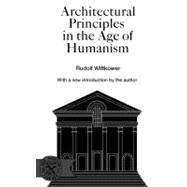
Architectural Principles in the Age of Humanism
by Wittkower, RudolphBuy Used
Rent Textbook
New Textbook
We're Sorry
Sold Out
eTextbook
We're Sorry
Not Available
How Marketplace Works:
- This item is offered by an independent seller and not shipped from our warehouse
- Item details like edition and cover design may differ from our description; see seller's comments before ordering.
- Sellers much confirm and ship within two business days; otherwise, the order will be cancelled and refunded.
- Marketplace purchases cannot be returned to eCampus.com. Contact the seller directly for inquiries; if no response within two days, contact customer service.
- Additional shipping costs apply to Marketplace purchases. Review shipping costs at checkout.
Summary
Table of Contents
| The Centrally Planned Church and the Renaissance | |
| Alberti's Programme of the Ideal Church | p. 16 |
| Centralized Churches in Later Architectural Theory | p. 22 |
| Building Practice: S. Maria delle Carceri | p. 29 |
| Bramante and Palladio | p. 31 |
| The Religious Symbolism of Centrally Planned Churches | p. 38 |
| Alberti's Approach to Antiquity in Architecture | |
| The Column in Alberti's Theory and Practice | p. 41 |
| S. Francesco at Rimini | p. 43 |
| S. Maria Novella | p. 47 |
| S. Sebastiano and S. Andrea at Mantua | p. 51 |
| The Change in Alberti's Interpretation of Classical Architecture | p. 59 |
| Principles of Palladio's Architecture | |
| The Architect as 'uomo universale': Palladio, Trissino and Barbaro | p. 60 |
| Palladio's Geometry: The Villas | p. 67 |
| Palladio and Classical Architecture: Palaces and Public Buildings | p. 75 |
| The Genesis of an Idea: Palladio's Church Facades | p. 89 |
| Palladio's Optical and Psychological Concepts: Il Redentore | p. 97 |
| The Problem of Harmonic Proportion in Architecture | |
| Francesco Giorgi's Platonic Programme for S. Francesco della Vigna | p. 104 |
| The Mean Proportionals and Architecture | p. 107 |
| Alberti's 'Generation' of Ratios | p. 111 |
| Musical Consonances and the Visual Arts | p. 113 |
| Palladio's 'fugal' System of Proportion | p. 119 |
| Palladio's Ratios and the Development of Sixteenth-Century Musical Theory | p. 123 |
| The Break-away from the Laws of Harmonic Proportion in Architecture | p. 130 |
| Francesco Giorgi's Memorandum for S. Francesco della Vigna | p. 138 |
| The Problem of the Commensurability of Ratios in the Renaissance | p. 140 |
| Bibliographical Notes on the Theory of Proportion | p. 142 |
| Proportion in Art and Architecture: an amalgamation of previously unpublished lectures by Professor Wittkower | |
| The Need for Order | p. 145 |
| Origins of Western Proportional Systems | p. 147 |
| Geometry and Mediaeval Proportions | p. 150 |
| Renaissance Proportions and Commensurability | p. 152 |
| Post-Renaissance Proportioning--Dilemmas and Possibilities | p. 154 |
| Index | p. 156 |
| Table of Contents provided by Syndetics. All Rights Reserved. |
An electronic version of this book is available through VitalSource.
This book is viewable on PC, Mac, iPhone, iPad, iPod Touch, and most smartphones.
By purchasing, you will be able to view this book online, as well as download it, for the chosen number of days.
Digital License
You are licensing a digital product for a set duration. Durations are set forth in the product description, with "Lifetime" typically meaning five (5) years of online access and permanent download to a supported device. All licenses are non-transferable.
More details can be found here.
A downloadable version of this book is available through the eCampus Reader or compatible Adobe readers.
Applications are available on iOS, Android, PC, Mac, and Windows Mobile platforms.
Please view the compatibility matrix prior to purchase.
